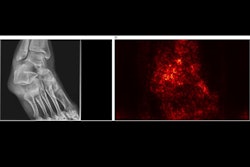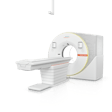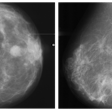CHICAGO – A commercially available AI model helped identify patients at risk of low bone mineral density (BMD) in a real clinical setting, according to a December 4 presentation at RSNA.
Most significantly, within six months of the AI findings, 19% of patients underwent follow-up dual-energy x-ray absorptiometry (DEXA) exams, the gold standard for diagnosing osteoporosis, noted Andrew Jayarajah, MBChB, of Sunnybrook Health Sciences Centre in Toronto, Ontario.
“Opportunistic screening for low BMD with Rho has the potential to help address low screening rates for fracture risk and osteoporosis,” Jayarajah said.
Osteoporosis, often referred to as the “silent disease,” is difficult to detect early and often is only diagnosed after individuals experience fractures. Low BMD is one of the clinical indicators of the disease. Rho (16 Bit, Toronto) is an algorithm designed to analyze standard x-rays (frontal projections of the chest, thoracic spine, lumbar spine, pelvis, knee, and hand/wrist) for markers of low BMD.
In this study, Jayarajah and colleagues investigated the clinical adoption and perceived value of Rho after deploying it to opportunistically identify patients at risk for low BMD when they presented for x-rays. Radiologists had the option of including the Rho findings in their reports.
Patients (n = 1,142) who were 50 years of age and older were included if they underwent an x-ray for any clinical indication that included an eligible body. Patients completed a prestudy questionnaire during the screening visit, as well as a second study questionnaire at the end of the study. Family physicians of the patients who had a Rho finding (likely low BMD) included in their x-ray report were also asked to rate the effectiveness of Rho and provide feedback on AI screening.
Out of the 1,142 patients screened, 452 women and 201 men were Rho-positive for low BMD. Radiologists included these findings in 80% of their reports. Out of these patients, 67% had not previously discussed osteoporosis or fracture risk with their doctor prior to the study, Jayarajah noted. In addition, 85 women (19%) and 39 men (19%) who had positive Rho findings underwent follow-up DEXA exams, with 50 women and 13 men subsequently diagnosed with moderate or high fracture risk, according to the findings.
“Some of the patients who returned for DEXA had not previously discussed bone health with their doctor, suggesting the Rho finding initiated the often overlooked screening process,” Jayarajah said.
Also, the family physician survey yielded 51 responses; 78% supported that Rho would be beneficial for patient care and 74% said they would use Rho screening information in their standard of care.
Ultimately, the study suggests that the Rho screening tool can identify patients at risk of low BMD in a real clinical setting. Radiologists incorporated the positive Rho results in their reports, and family physicians find these results useful, Jayarajah said.
“Opportunistic screening for low BMD with Rho has the potential to help address low screening rates for fracture risk and osteoporosis,” he concluded.
For full 2024 RSNA coverage, visit our RADCast.



















